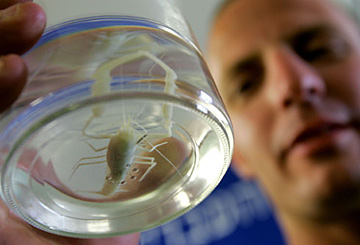
|  |  |  Editorials | Environmental Editorials | Environmental  
Analysis of Blind Scorpions in Mexico Suggests Adaptation to Caves is Reversible
 ANI ANI
go to original
March 14, 2010


| | Scorpions are predatory, venomous, nocturnal arachnids that are related to spiders, mites, and other arthropods. |  |
A new phylogenetic analysis of blind scorpions that live in the stygian depths of caves in Mexico has suggested that adaptation to caves is reversible, which is evidence that specialized adaptations are not evolutionary dead ends.

The analysis revealed that scorpions currently living closer to the surface (under stones and in leaf litter), evolved independently on more than one occasion from ancestors adapted to life further below the surface (in caves).

"Our research shows that the evolution of troglobites, or animals adapted for life in caves, is reversible," said Lorenzo Prendini, Associate Curator in the Division of Invertebrate Zoology at the American Museum of Natural History.

"Three more generalized scorpion species living closer to the surface evolved from specialized ancestors living in caves deep below the surface," he added.

Scorpions are predatory, venomous, nocturnal arachnids that are related to spiders, mites, and other arthropods.

About 2,000 species are distributed throughout the world, but only 23 species found in ten different families are adapted to a permanent life in caves.

These are the specialized troglobites.

This study concentrates on the family Typhlochactidae that includes nine species of scorpions endemic to the karstic regions of eastern Mexico.

All species in the family have adapted to the dark with features such as loss of eyes and reduced pigmentation.

Three of the species live closer to the surface and are more generalized morphologically than the other six, making this family an excellent model with which to test and falsify Cope's Law of the unspecialized and Dollo's Law of evolutionary irreversibility.

For the current research paper, Prendini and colleagues gathered data for 195 morphological characteristics, including a detailed mapping of the positions of all trichobothria (sensory setae) on the pedipalps, among the species of Typhlochactidae.

The resulting phylogenetic tree shows that adaptation to life in caves has reversed among this group of scorpions.

Two of the less specialized, surface-living species, T. mitchelli and T. sylvestris, share a common ancestor with a much more cave-adapted species, and a similar pattern was found for the third less specialized, surface-living species, T. sissomi.

"Scorpions have been around for 450 million years, and their biology is obviously flexible," said Prendini.

"This unique group of eyeless Mexican scorpions may have started re-colonizing niches closer to the surface from the deep caves of Mexico after their surface-living ancestors were wiped out by |

 |
|  |



